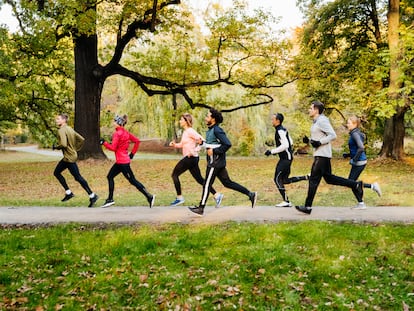Texas faces epidemic of diabetes amputations
In Bexar County, near the Mexican border, more than a tenth of residents has been diagnosed with the disease. Seven out of every 10 amputations in the state are performed there, about 2,000 each year. The Latino community is the most affected
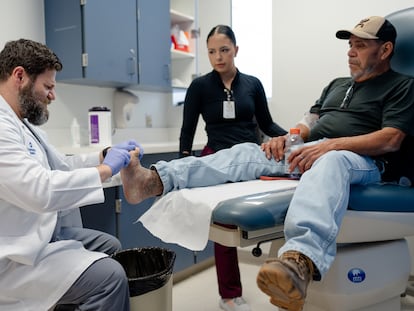
Michael Sobolevksy smiles at a foot, a foot without two toes, a battered foot that has been saved from being amputated. And he smiles at the owner of that foot and says some words in Spanish. Sobolevksy — a Russian-born podiatrist who lives in South Texas — takes the time to patiently do his job, as if he were caring for a baby. He takes his time even though he has many patients in the waiting room, almost all men of Latino descent of working age, who have lost — or will soon lose — a body part as a result of diabetes. Year after year, Bexar County has the highest rate of lower limb amputations due to diabetes in both Texas and the United States: 69.9 per 100,000 hospitalizations.
One morning in May, José Reséndez arrives at the University Health Texas Diabetes Institute clinic for a routine checkup after undergoing surgery for an ulcer on his right foot, which now only has three toes. He must take an antibiotic for four weeks and wear a special shoe to protect the wound. Far from the eyes of the doctors, he will change into formal shoes for a few hours to accompany his pre-teen daughter to a school dance. “Don’t tell the doctor I took off my shoe,” he says with a mischievous face when posing for photos.
Sobolevksy, who has thick hair and dark beard, attaches a skin-cleansing device that opens a window to Resendez’s bone. “Patients can have a cut, they can have a wound and not even notice it,” the doctor says. “That wound can get infected, they need antibiotics, they need surgery, most wouldn’t need an amputation, but often they don’t know how bad it is and, when they come to the clinic, we have to fight the infection and try to save the foot.”

In the United States, amputations have doubled since 2009, especially in Black communities. Latinos face several difficulties in the face of the disease: a low percentage of health insurance, unfamiliarity with the health care system, high levels of medical mistrust, and language barriers. Eighty percent of surgeries to remove a toe, foot or leg are due to complications with diabetes. A study by the American Heart Association showed that Hispanic patients tend to seek medical help later, when the disease has already progressed. Many receive the news of an amputation at the first doctor’s visit, when there is no other option.
If you look at the map of diabetes in the country, the most intense color is in the south. And if the number of cases in Texas is already of concern, it is even more alarming in Bexar, a county that also includes the city of San Antonio. Just over a tenth of the residents of this county, which is near the border with Mexico, have been diagnosed with the disease, according to the San Antonio Metropolitan Health District. Seven out of every 10 amputations in Texas are performed in Bexar, about 2,000 each year. The mortality rate also rose by 40% between 2018 and 2021. The county with the most deaths from diabetes in the United States is San Bernardino, in California; Bexar is the second, and the Bronx, in New York, is third.
When a person has a family history of diabetes, it is critical that they look after themselves. Reséndez’s father had diabetes, as did his grandmother, his uncle and other family members. His first wife died of cancer and he raised their children. Ten years ago, he remarried. He lives with Gabriela and his 10-year-old girl, whom he accompanies to her school dances and sports games.
Migrant and not white
Dr. Sobolevsky was born and raised in Russia. Upon arriving in the United States, he studied in Austin and at the Dr. William M. Scholl College of Podiatric Medicine in Chicago. He worked in different hospitals throughout the country, but it was in San Antonio that he noticed the enormous number of diabetes cases. At University Health he completed his residency and he is still there, a decade later.
“You see how much diabetes impacts people, it affects their personal and professional lives, their quality of life. Many of these patients are immigrants, just like me, immigrants who are not white, who have to be able to walk, drive, use their legs, it really hurts,” he says passionately. Many of his patients have jobs in rough trades and work for cash. If they don't go, they don't get paid. “We do everything possible to get them back on their feet so they can provide for themselves and their families.”
Reséndez does not have health insurance and Sobolevsky will not charge him for this consultation. The doctor knows Reséndez must work to pay for rent, food and car insurance, which are necessary in these cities where there are not even sidewalks to walk safely. He is one more case in an overwhelming statistic, for every three men with diabetes, one woman suffers from the disease. In the offices, the average age of patients is 30 and 40 years old, a decade ago the majority were 50 to 60. Sobolevsky now sees minors, practically children, aged between 12 and 16.
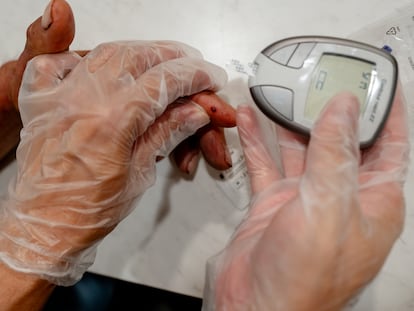
Reséndez was diagnosed with diabetes at the age of 36. He developed a terrible thirst that he tried to quench by drinking as much water as possible. He went to the bathroom up to 12 times a night and couldn’t sleep. Shortly after the diagnosis, he began to feel better. He returned to sweet cravings and Coca Cola. Fifteen years later they were able to save his feet but they removed three toes. “The only thing I took care of was my sugar levels, I was careless, I didn’t take my medicine,” he admits.
The disease began to take a heavier toll. “It attacks all your organs, you don’t realize it until it’s advanced.” Now he can’t stand up safely, and if he loses his balance even a little he will fall flat on his face. “You have no way to stop anymore because you don’t have those toes.” He has also been losing his eyesight, he can’t see his phone and he uses glasses to see things that are far away. Diabetes is the number one cause of blindness in adults, according to the Centers for Disease Control and Prevention (CDC).
Sometimes patients do not have support networks, nor can they take care of themselves even if they have a serious wound. “Those are the barriers that keep this population more susceptible to the complications of the disease,” explains Sobolevsky.
Reséndez has no choice but to follow the doctor’s orders. No sugar or fast food, none of that. “It’s not easy, especially because we love sweetbread, cookies, things like that. We love Coca Cola,” admits this 57-year-old man who was born on the U.S. side of the border with Mexico. He speaks two languages, but is most comfortable with Spanish.
What’s more important after surgery is for the patient to heal and to be able to continue with their life with the highest quality possible. This involves education, from how to manage sugar levels to how to coordinate getting them into fitted shoes. The goal is to try to get them back on their feet, with physical therapy or prostheses.
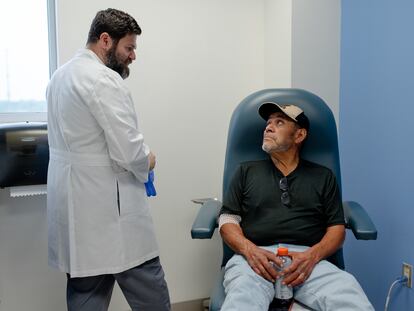
Bionic leg and marathon runner attitude
When he was a boy, Polo Guajardo did all kinds of sports and training, until one day he went in for a simple medical exam to join the police academy and the doctor told him the news: he had diabetes. He was 19 years old and didn’t take it very seriously. “I continued eating the same things even though I didn’t exercise as much as before,” says Guajardo, with both hands on his jeans. He’s kind, but his gaze is like a security camera. He smiles when he talks about his grandchildren; he has their drawings taped to the refrigerator door. He smiles when he talks about his daughter. And he smiles when he explains that his two dogs cry and bark because when he is home they just want to be with him.
His left foot was amputated from the knee down and he wears a prosthetic limb. “I can’t do everything I did before. But I haven’t stopped working, I have never wanted to get out of working. I like what I do, that’s why I keep going,” says this 50-year-old Texan of Mexican descent. He works at a local jail and has a good position. He has to review reports, papers, issues concerning the prisoners and the staff. His schedule is like hospital shifts, long hours and nights away from home. He misses the action, but he has resigned himself to it.
Now he is strict with his meals. He doesn’t have sugar at home. His home has his grandchildren’s drawings on the refrigerator, some police handcuffs hanging along with the keys to the house and his car. Also a well-equipped gym in the back yard. He goes for a walk every day in the afternoon and sometimes rides a bicycle. His biotic leg is modern, from a manufacturer with a branch in Austin, and costs between $5,000 and $6,000. But he has health insurance; many don’t. Texas has the highest rate of people without health insurance in the entire country; in 2022, 17% of the population lacked any type of health protection (almost five million people).
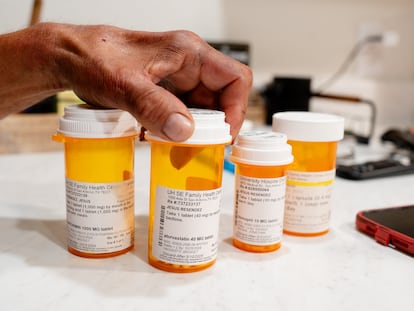
The Texas Diabetes Institute serves between 8,000 and 10,000 people a year and a large proportion is of Latino origin, says doctor Alberto Chávez Velázquez, an endocrinologist specialized in diabetes and metabolism at the same hospital. He has been working at the institute for nine years and is Mexican; he was born in the border city of Matamoros, Tamaulipas. “The incidence of diabetic foot ulcers and amputations is as high as 2% of the general population,” he confirms.
Most of the amputation cases are in the southern area of San Antonio, neighborhoods with single-story houses and modest but flourishing gardens. The facades are painted a mosaic of intense colors. The city government, hospitals and civil organizations have support groups and outpatient clinics. Information about the disease is key because Type 2 diabetes is largely preventable and accounts for nearly 95% of diagnoses in the United States.
Guajardo believes that the sexist culture is a big barrier to prevention. “My parents are from Mexico, from Coahuila. Mexicans are stubborn, we don’t pay attention if something hurts us. If we feel bad, we don’t go to the doctor. But then the bad stuff comes, they tell you that they are going to amputate your foot, and there are many people who don’t want to do that, even if it’s going to save their life, they prefer to die. Sooner or later… rather sooner, they die, the infection has a very strong effect on the blood,” he says.
He is not the only one who thinks this way. “It hits you where it hurts you the most, in your manhood,” Reséndez confesses. Although he lost three toes, he still considers himself “a lucky person” as he was able to keep his legs.
Sign up for our weekly newsletter to get more English-language news coverage from EL PAÍS USA Edition
Tu suscripción se está usando en otro dispositivo
¿Quieres añadir otro usuario a tu suscripción?
Si continúas leyendo en este dispositivo, no se podrá leer en el otro.
FlechaTu suscripción se está usando en otro dispositivo y solo puedes acceder a EL PAÍS desde un dispositivo a la vez.
Si quieres compartir tu cuenta, cambia tu suscripción a la modalidad Premium, así podrás añadir otro usuario. Cada uno accederá con su propia cuenta de email, lo que os permitirá personalizar vuestra experiencia en EL PAÍS.
¿Tienes una suscripción de empresa? Accede aquí para contratar más cuentas.
En el caso de no saber quién está usando tu cuenta, te recomendamos cambiar tu contraseña aquí.
Si decides continuar compartiendo tu cuenta, este mensaje se mostrará en tu dispositivo y en el de la otra persona que está usando tu cuenta de forma indefinida, afectando a tu experiencia de lectura. Puedes consultar aquí los términos y condiciones de la suscripción digital.
More information
Archived In
Últimas noticias
The complicated life of Francesca Albanese: A rising figure in Italy but barred from every bank by Trump’s sanctions
Half of Scotland is in the hands of 420 property owners
Reinhard Genzel, Nobel laureate in physics: ‘One-minute videos will never give you the truth’
Pinochet’s victims grapple with José Antonio Kast’s rise in Chile
Most viewed
- Pablo Escobar’s hippos: A serious environmental problem, 40 years on
- Why we lost the habit of sleeping in two segments and how that changed our sense of time
- Charles Dubouloz, mountaineering star, retires at 36 with a farewell tour inspired by Walter Bonatti
- Trump’s obsession with putting his name on everything is unprecedented in the United States
- The Florida Keys tourist paradise is besieged by immigration agents: ‘We’ve never seen anything like this’
